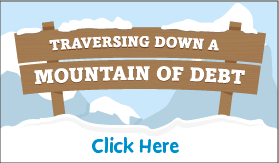8 Ways to Combat High APR Problems
What is high APR and how can you lower it?
While convenient, credit cards are notorious for their higher interest rates than loans. This means carrying a balance can quickly become costly. While promotional 0% periods exist, most cards’ standard Annual Percentage Rate (APR) is substantial. But what exactly constitutes a “high” APR, and how can you take control?

To understand if your credit card interest rate is too high, it helps to know the averages. Here’s a quick look at typical credit card APRs today:
- Standard APR: Around 22%
- Reward Card APR: Frequently above 24%
- APR with Challenged Credit: Often exceeding 27%
You can find the interest rates for your accounts on your monthly credit card statement. They are usually listed in a table on your statement’s first page. Compare the rates above to your credit card interest rates to see if yours are high.
The reality of “average”
Even if your rate falls within these averages, these APRs are still high and can cost you if you don’t pay down your card in full each month. These rates mean a larger portion of your payments goes towards interest, not the principal.
To help you minimize these costs, we’ll go over effective strategies to reduce your APR so you can make a plan to eliminate your credit card debt.
#1: Negotiate lower interest rates
The first thing you should do if your rates are high compared to the rates above is to call your creditors. Unlike loans, credit card interest rates are not fixed at the time you open the account. They can change, often because you negotiate to reduce the rate.
Interest rate negotiation is not guaranteed. You will have more success if you:
- Always make your payments on time
- Have been a loyal customer for a number of years
- Improved your credit score since you opened the account
- Have not maxed out the account
To negotiate your interest rate, call your credit card customer service number. Prepare by knowing your current APR, researching competitor rates, and highlighting your positive payment history. Be polite and persistent, ask for a specific rate reduction, and document the conversation. If denied, consider calling again and trying with a different representative or asking to speak with a supervisor.
Find more tips for interest rate negotiation »
#2: Target your debt by APR
Even if your creditors agree to reduce your rates, you will still spend money each month on high interest charges as long as you have credit card debt. The only way to avoid interest charges on high APR credit cards is to start a billing and end billing cycles with a zero balance. If you pay off your charges in full every month, high APR won’t be a problem.
If you’re concerned about APR now, it’s probably because you carry balances over from month to month. In this case, you need to implement a debt reduction plan. To do this, first streamline your budget to maximize the money you have available to pay down your debts. hen, employ the ‘debt avalanche’ method: pay the minimum on all cards except the one with the highest APR, and throw every extra dollar at that top-priority debt. This approach slashes overall interest costs, accelerating your path to debt freedom.
#3: Devote all extra cash to debt elimination
In addition to your debt reduction plan, you should devote all extra cash to paying off your credit card debt. That includes tax refunds, holiday bonuses and birthday cash. You can convert gift cards, sell items you don’t need, pick up a side job – anything to pay off debt.
Remember, the faster you eliminate your debt, the more you minimize interest charges. This is why you pay off debt starting with the highest APR; they cost more each month they linger. By focusing your energy on getting out of debt faster, you reign in runaway interest charges.
#4: Set up a repayment plan with the creditor
If you have multiple credit card debts to repay and you’re struggling meeting the minimum payments, set up repayment plans. Creditors don’t want to send your account to collections. It will be a loss for them, both in revenue and of a loyal customer. They want to keep you and your account in good standing. So, you can ask to make payment arrangements when you run into trouble.
They will usually close your account temporarily so you can’t make new charges. Then they will set a payment that you need to ensure you can meet every month. Falling off of a repayment plan can result in penalties and the creditor is unlikely to work with you again.
#5: Consolidate the debt with a personal loan
As we mentioned at the top, loans have low interest rates compared to credit cards. So, another solution to challenges with high interest rate credit cards is debt consolidation. You take out a personal loan with a low interest rate, then use the funds to pay off your credit cards. This leaves only the low interest rate loan with a fixed payment to pay back.
Infographic
Reach Zero Faster with Debt Consolidation
Credit card debt consolidation can help you traverse down a mountain of unpaid debt faster and easier. Learn how to reach the debt-free finish line….
Read moreJust be careful not to run the balances back up on your high APR credit cards.
A good credit score is typically needed for this strategy. You’ll need to qualify for a consolidation loan with an APR lower than your current credit card rates, and poor credit may hinder both qualification and favorable terms.
#6: Use a credit card balance transfer
You can also consolidate debt using a new credit card. Balance transfer credit cards allow you to transfer existing balances to a new account at 0% APR. That rate only lasts for a certain period of time, known as an introductory period. Once it ends, the regular balance transfer APR on the card kicks in. Currently, the average APR on balance transfer credit cards is slightly over 19%.
The length of the introductory period depends on your credit score; they generally range from 6 months to 18 months. Your goal is to pay off the debt before the real rate applies. This strategy usually only works for limited debt amounts and if you have good credit.
#7: Use part of a Home Equity Line of Credit
Most experts would recommend that you should not take out a home equity loan solely for the purpose of paying off credit card debt. However, if you have extra funds from a home equity loan or HELOC, it would lower the interest rate. A Home Equity Line of Credit is a set amount of money you can borrow against based on the equity in your home.
If you have extra funds, you can use some of the money to pay off some credit cards. However, it’s not recommended to borrow against your equity only for credit cards. This effectively converts unsecured debt into secured. Now the debt uses your home as collateral, so if you fall behind on the payments you could face foreclosure.
Talk to a HUD-certified housing counselor to see if using home equity is a good choice for you.
#8: Enroll in a debt management program
A debt management program is basically a professionally assisted debt consolidation and repayment plan. You enroll through a consumer credit counseling agency. They set up a payment plan that you can afford, then negotiate with your creditors. Even if you couldn’t negotiate lower interest rates, credit counselors can reduce or eliminate your APR. That’s because the agencies have established relationships with creditors and proven records of success in helping borrowers regain stability.
One of the best things about a DMP is that you don’t need good credit to qualify for it, and completion of a DMP can even help improve your credit score.
Explained in 60 seconds: Debt Management
Learn how you can craft a customized debt management program with the help of a credit counselor. A DMP can reduce or eliminate interest charges, allowing you to get out of debt faster even though clients pay up to 30-50% each month, on average.
[Narrator] Debt management doesn’t have to be so confusing. Here’s a quick and easy 60-second snapshot of how debt management works.
[On-screen text] Debt management
[Narrator] In normal circumstances, you manage all of your debt on your own, paying off as much as possible each month to avoid issues.
[On-screen text] Credit card = $15,264.00
[Narrator] But when credit card debt gets out of control, the bills outstrip what you can afford to pay.
[On-screen text] Debt management program
[Narrator] A debt management program helps you rein in runaway debt by combining all of your unsecured debt into one payment
[On-screen text] All debts, one payment
[Narrator] You only have to worry about one bill each month, so you’re not juggling multiple payments.
[On-screen text] Jan = $376.00
[Narrator] Plus, with interest that’s reduced or eliminated completely, you can get out of your debt faster even though you pay less each month
[On-screen text] 24%… 15%… 10%… 6%. Get out of debt faster!
[Narrator] Instead of the decades it takes to pay off debt on a minimum payment schedule, most people are debt free in 60 payments or less.
[On-screen text] Debt Free: Sixty months or less
So, if you’re feeling overwhelmed and see rainy days ahead, we can help.
[On-screen text] ConsolidatedCredit.org, 1-800-320-9929
[Narrator] Call Consolidated Credit today for a free debt evaluation with a certified credit counselor. Together, we can create a customized debt management program so you can finally get your debt under control.
Get a free evaluation to find the best way to reduce your interest rates.
